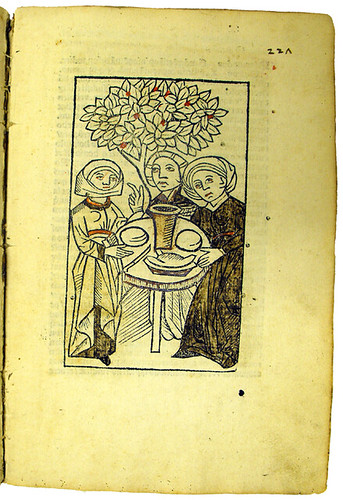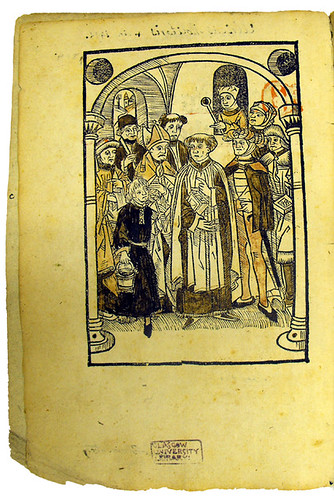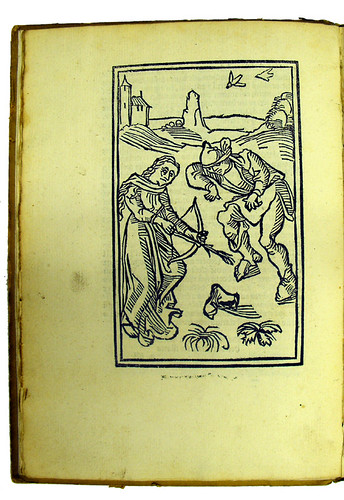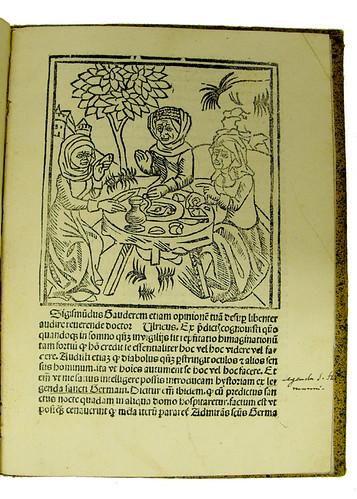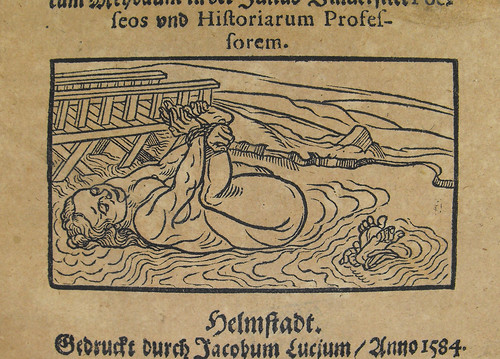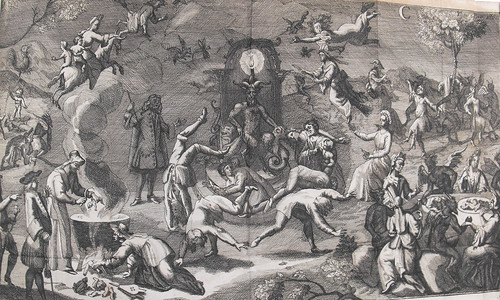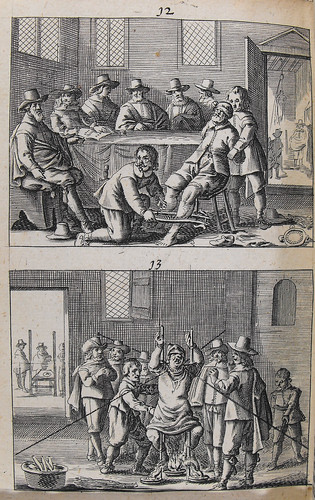Witchcraft and Demonology in: Germany, Switzerland and the Low Countries
Alphonso, de Espina, 15th cent. Fortalitium fidei.
[Strassburg [i.e. Strasbourg], Johann Mentelin, not after 1471]; folio (Sp Coll Hunterian Bx.1.5)
Alphonso de Espina, a Spanish Franciscan who was a convert from Judaism, became confessor to King John of Castille, director of studies of the Friars Minor at Salamanca, and was created Bishop of Thermopylae in 1491.
The Fortalitium fidei written 1458-60, is the first printed book to contain a description of witchcraft. The fifth and final part of the work is devoted to an account of ten classes of demons, the last of which persuade old women (called sorguinae or bruxae) that they can work evil. He mentions gatherings or assemblies of such women (i.e. witches’ sabbats) in the south of France, and adds that many have been arrested and burnt.
Nider, Johannes, c. 1380-1438. Formicarius.
Augsburg, Anton Sorg [c. 1484]; folio (Sp Coll Ferguson An-y.9)
The Formicarius, written 1435-37 during the Council of Basle and first printed in 1475, is the second book ever printed to discuss witchcraft. This is a copy of the second edition. Nider dealt specifically with witchcraft in the fifth section of the book. Unlike his successors, he did not emphasize the idea of the witches’ sabbat and was sceptical of the claim that witches could fly by night. An important work which shows that by the early fifteenth century trials and torture of witches were already taking place.
Sprenger, Jakob, 1436 or 8-1495. Institoris, Heinrich, 1430-1505. Malleus maleficarum.
Nuremberg, Anton Koberger, 17 March 1494; quarto (Sp Coll Ferguson An-y.12)
First printed in 1486, the Malleus maleficarum is "...without question the most important and most sinister work on demonology ever written..." - R.H. Robbins, The encyclopedia of witchcraft and demonology. Its aim was to eradicate witchcraft entirely. Its influence and authority were secured by the papal bull obtained in 1484 by Heinrich Institoris from Innocent VIII which verified the claims of the witch-hunters, and by the fact that it provided a complete guide for the discovery, examination, torture, trial, and execution of witches.
There were at least twenty-nine editions of the Malleus up to 1669. The Ferguson Collection has eight editions of the work, of which five were printed before 1500.
Molitor, Ulrich, fl. 1470-1501. De lamiis et phitonicis mulieribus.
[Strassburg [i.e. Strasbourg], Johann Pruss, not before 10 January 1489]; quarto (Sp Coll Ferguson An-y.35)
Molitor was a professor at the University of Constance. This work was written in the form of a discussion between Molitor, Archduke Sigismund of Austria, and Conrad Schatz (chief magistrate of Constance); it was designed to remove the doubts and objections raised by Sigismund concerning the existence of witchcraft.
Klebs, Incunabula scientifica et medica, lists thirteen Latin editions and three German, all printed before 1500. These are usually illustrated with six (sometimes seven) woodcuts, the same woodcuts being closely copied in successive editions.
Molitor, Ulrich, fl. 1470-1501. De lamiis et phitonicis mulieribus.
[Reutilingen, Johann Otmar, not before 10 January 1489]; quarto (Sp Coll Ferguson An-y.34)
Includes a woodcut of two witches being taken by a demon to a sabbat. All are mounted on a cleft stick and the witches’ heads have taken on animal form. This is the earliest printed picture of witches in flight. Also includes an illustration of a witch wielding a bow and arrow.
Molitor, Ulrich, fl. 1470-1501. De lamiis et phitonicis mulieribus.
[Cologne, Cornelis de Zierikzee, about 1500]; quarto (Sp Coll Ferguson An-y.13)
Includes a woodcut of two witches who are standing over a cauldron and producing a storm.
Molitor, Ulrich, fl. 1470-1501. Hexen Meysterei. [i.e. De lamiis et phitonicis mulieribus. German.]
[Constance?] 1544; quarto (Sp Coll Ferguson Ag-c.8)
A later edition in German of Molitor’s De lamiis et phitonicis mulieribus. Illustrated with eight woodcuts, some of which are repeated to make a total of twelve illustrations.
Weyer, Johann, 1515-1588. De praestigiis daemonum.
Basiliae [i.e. Basel], per Ioannem Oporinum, 1563; octavo (Sp Coll Ferguson Ah-e.11)
Weyer was a pupil of Cornelius Agrippa and later became physician to Duke William of Cleves, to whom this book is dedicated.
This is the first edition of one of the most important of the few early books to oppose the believers in witchcraft. Together with Scot’s The discouerie of witchcraft, 1584, it helped to provoke the Daemonologie of James I.
Weyer attempted a distinction between ignorant old women, whom he considered harmless, and subtle magicians, taught and aided by Satan. He denounced the contmporary excesses of torture and imprisonment.
Neuwaldt, Hermann, d. 1611. Bericht von Erforschung/Prob vnd Erkentnis der Zauberinnen durchs kalte Wasser...
Helmstadt, Gedruckt durch Jacobum Lucjum, 1584; quarto (Sp Coll Ferguson Ag-d.42)
An account of ordeal by immersion in water, a favourite method of determining the guilt or innocence of those accused of witchcraft. If the suspect floated she was guilty, if she sank she was innocent.
The chief European exponent of the swimming of witches was Wilhelm Adolf Scribonius, against whose views this pamphlet was written.
Del Rio, Martin Antoine,1551-1608. Disquisitionum magicarum libri sex.
Moguntine [i.e. Mainz], Apud Ioannem Albinum, 1603; folio (Sp coll Ferguson Ah-y.9)
Del Rio was a widely travelled Jesuit scholar and a prolific writer.
This work, first published at Louvain in 1599, became as famous as the Malleus maleficarum, and by 1747, the date of its final printing, it had gone into about twenty editions. The book is divided into six parts which deal with: magic in general, diabolical magic, maleficia, prophecy and divination, rules for judges, function of the confessor.
Spee, Friedrich von, 1591-1635. Cautio criminalis.
Solisbaci [i.e. Sulzsbach], Sumpt. Martini Endter, 1695; duodecimo (Sp Coll Ferguson Ai-g.4)
This work was first published in 1631 and ran into sixteen editions (including French, German, Dutch and Polish translations) within a hundred years. The book consists of fifty-one dubia or questiones, dealing generally with the subject of witchcraft, and especially with its existence and the method of suppressing it in Germany.
Spee, a German Jesuit, was the next writer after Weyer to attack the persecution of witches. He had personal experience of witch trials in Germany (he acted as confessor at Wurzburg to those charged with witchcraft) and concluded that the majority of those condemned were innocent.
An inscription on the title page indicates that this copy once belonged to the Austin Friars at Wurzburg, the town which was one of the centres of the persecution of witches.
Grosse, Henning, 1553-1621. Magica de spectris et apparitionibus spiritu de vaticiniis, divinationibus &c.
Lugd. Batavorum [i.e. Leiden], Apud Franciscum Hackium, 1656; duodecimo (Sp Coll Ferguson Ai-g.31, Sp Coll Ferguson Ag-d.75)
The engraved title page shows a witches’ sabbat with a witch stirring a cauldron in the foreground. Most writers stressed the important part played by the cauldron in preparations for the sabbat. Pierre de Lancre, for example, observed that it was in the cauldron that the witches prepared every sort of poison for hurting or killing men and marring cattle.
Bordelon, Laurent, 1653-1730. L’histoire des imaginations extravagantes de Monsieur Oufle.
Amsterdam, Estienne Roger et al., 1710; duodecimo (Sp Coll Ferguson Ai-f.6)
Oufle, an anagram for "le fou" (the madman), sets the tone of this work, which is a satire on believers in witchcraft and demonology. The work contains ten illustrations depicting Monsieur Oufle’s adventures with apparitions, astrologers, and sorcerers. Perhaps the most striking plate is that of a witches’ sabbat.
Bodelon was the chaplain of St. Eustache in Paris.
Palingh, Abraham. ‘tAfgerukt mom-aansight der tooverye.
Amsterdam, Andries van Damme, 1725; octavo (Sp Coll Ferguson Al-d.13)
This book consists of a lengthy discussion about the facts of sorcery and possession by demons. It is written in the form of a dialogue, carried on by three sorcerers named Tymon, Eusebius, and Mantus. Most of the engravings in the work show people afflicted with various forms of demoniacal possession, but the illustrations also include depictions of a man being tortured with the "crocodile jaws" and a spiked collar.
Back to the Introduction
Forward to see books on Witchcraft and Demonology in France and Italy










